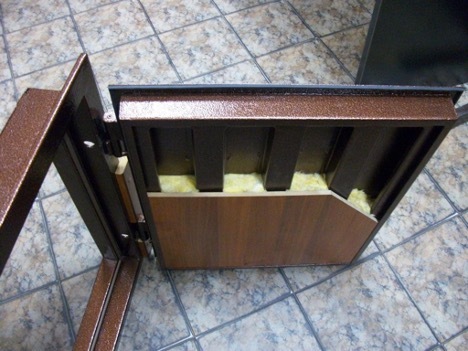To understand which entrance door is best for a soundproof apartment, you need to pay attention to its composition and dimensions. The main attention is paid to the filler, the thickness of which should be at least 80 mm. Other criteria are also of some importance - all of them are discussed in detail in the presented material.
The content of the article
- Soundproofing classes
- Soundproof door device
- What does noise reduction depend on?
Soundproofing classes
On the one hand, you can understand the technical details, consider each criterion separately. But on the other hand, it is useful to know that the soundproofing of the front door is characterized by belonging to 1 of the 3 classes described in GOST 31773-2003. According to this normative document, there are such classes:
- The first - with the least pronounced properties. Absorbs only sounds within 25 dB.
- The second is noise absorption within 31 dB.
- The third is sound absorption with a power of 32 dB.
To understand how to choose a soundproof front door, you need to figure out how to evaluate the sound power. So, 45 dB corresponds to a normal calm conversation if the interlocutors are at a distance of 1-1.5 m from each other.

It is clear that the strength of the sounds in the entrance can be different. But as a rule, these are distant voices. Therefore, entrance doors with good insulation are a third class construction.
On the other hand, models are often labeled in a different way. Noise isolation of an entrance metal door can also be indicated by an English letter:
- A + 1 is the best option, which corresponds to grade 3. Attenuates even the loudest sounds. Suitable for city apartments.
- B - approximately corresponds to class 2, well suited for private houses, but is no longer recommended for apartments.
- C - extinguishes somewhat worse than B, although such entrance doors to an apartment with sound insulation are also good. They roughly correspond to class 2, mainly used in offices.
- D - doors dampen sounds poorly, corresponds to class 1.
- E - construction without filler to absorb sounds. These are the entrance doors to an apartment with sound insulation that you definitely shouldn’t install. They will not provide any protection.
Soundproof door device
In form and purpose, such a door does not differ from the usual one, however, it has a significantly greater thickness (at least 80 mm, often from 100 mm), which absorbs sound waves. The front door with good sound insulation consists of 2 parts:
- The box is the fixed part. It is installed in the opening, and then the door itself is hung on the jambs.
- The door leaf is a moving part that is opened and closed. It is in everyday life that they call it the door.
The canvas with noise-absorbing properties has a special structure:
- Metal coating 1.5-2 mm thick.
- Vertical stiffeners - 2 "sleepers", run longitudinally at a certain distance, ensure the integrity of the entire structure.
- Entrance metal noise-insulating doors must have a filler with a thickness of 80 mm or more. This can be, for example, mineral wool, polyurethane or other materials. They provide sound absorption and prevent the access of cold. The soundproofing class of the doors directly depends on the quality and quantity of the filler.
- Lock, door hardware.
- Finished interior panel, often with a mirror.
- Anti-removable crossbars - metal pins 2 mm thick. Provide protection in case of mechanical break-in.

What does noise reduction depend on?
When choosing a particular model, you need to deal with different criteria. One of the most important is which front door filler is better for soundproofing. This is indeed significant, but not the only indicator. It is recommended to pay attention to the following parameters:
- The layer thickness is at least 80 mm, it is better to consider models with 100 mm or more.
- There should be several layers - 4-5. If layers of different porosity and density alternate, this is the best option.
- Leaf material - good sound insulation of a metal door is provided by dense wood, such as oak, alder or walnut.
- The box is better built into the wall. Although a sealant can be laid in the gaps to ensure tightness.
As already mentioned, the sound insulation classes of entrance doors largely depend on the filler. The highest quality are:
- Foamed polyurethane is a durable material with a porous structure. If laid in several layers, the sound insulation of the front door is maximum. The advantage of polyurethane is its low weight and good sound absorption. In addition, the composition is resistant to temperature fluctuations, humidity levels. Does not rot, decay due to mold and bacteria.
- Mineral wool is a natural material based on molten silicates. It has a fibrous structure, due to which the door soundproofing index is one of the best.
- Foam concrete is a durable filler with numerous pores. It dampens sound waves well and also protects from the cold. An incomparable plus is the low weight.
- Noise isolation of the metal door in the apartment is also provided by isolon. This is polyethylene foam, which is often foil-coated, that is, covered on both sides with layers of aluminum foil. Materials not only dampen sounds, but are also resistant to moisture.
- Corrugated cardboard also protects against noise, but this is not the best filler. It is inexpensive and light in weight. It shows good efficiency only with a sufficient number of layers - at least 3.
- Considering how to choose a door with good sound insulation, you can also take a closer look at those fillers that are used in cars. This, for example, is a special felt that dampens strong sounds. There is also a filler STP GB. It consists of mastic with a foil coating.

Thus, when choosing a suitable model, one should look at sound insulation classes, layer thickness and design features. Equally important are general indicators - the quality of door fittings, completeness, the brand of the manufacturer. It is also worth taking care of proper installation, since even a small inaccuracy can lead to partial leakage.


